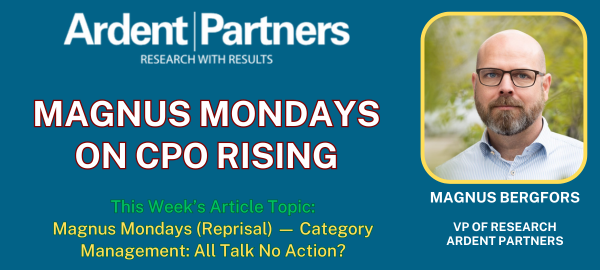[**Over the next few weeks, we’ll be running “best of” Magnus Mondays posts, reprising some of the most popular topics of the series. Magnus returns with new content in August.]
When I started in procurement in what feels like way too many years ago, it was as a buyer. A few years later I got a new title, strategic buyer! Nothing actually changed but I got a fancier title. Since then, it feels like the term “strategic buyer” has been replaced by category manager, but has anything really changed?
Last week I caught up with Michael Pleuger of akirolabs and we discussed the state of category management. akirolabs is a solution designed to help procurement organizations create, execute, and monitor category strategies (look for more solution details in a future article). Michael is one of the founders of akirolabs and has many opinions on category management, inspiring parts of this article. Let’s take a closer look at category management.
Category Management Is More Than Sourcing
First, I’m not criticizing category management as a concept. If implemented correctly and embedded in the organization, it can bring tremendous value and elevate procurement’s contribution and impact on overall enterprise performance. As Michael and I discussed, the problem is that very few organizations have successfully implemented category management.
Just renaming strategic buyers to category managers does not equate to practicing category management (surprising, I know). In fact, being a category manager is quite different from being a buyer. Personally I think, category managers should focus on strategy and longer-term development of both supply and demand. Actual sourcing events and negotiations should be ideally performed by — wait for it — a buyer who can leverage a center of excellence, as described in a previous article (It’s Time To Improve eSourcing Adoption).
The category manager should decide on what and how to source, as well as take part in the sourcing event design and award decision. Their involvement should not include sourcing event execution nor should the category manager participate in day-to-day operational issues like delivery changes, etc. This might seem obvious, but far too many category managers spend little time at the strategic level because they’re always chasing operational issues.
Kraljic Is Only One Tool
Another issue that came up in our discussion is that if companies are using a category management strategy model, it tends to be the Kraljic Matrix. The Kraljic Matrix was originally published in a 1983 Harvard Business Review article “Purchasing Must Become Supply Management.” There is nothing wrong with the Kraljic Matrix, and it should be part of category strategy development, but it only focuses on the supply side of the equation and how to manage the buyer-supplier power balance. Category management must also look at the demand side and the overall business objectives and incorporate those into the strategy. A strategy will look different when focusing on developing new innovative products and services or maximizing the profit margin of a product in a mature market, for example.
Make Category Management an Integral Part of Procurement
Perhaps the biggest issue is the major disconnect between category strategies or plans and the actual day-to-day work being done. Category plans are created or updated on an annual basis, then put in a drawer and left there until it’s time for the annual category strategy update.
Companies successful in implementing category management are those that incorporate both supply and demand sides, while collaborating across the organization ensuring that category strategies are aligned with business objectives and acknowledging existing limitations and requirements of impacted parts of the organization.. This assures that plans are both realistic and impact the right business metrics. What’s more, these same companies find category management implementation success within the procurement organization and its processes. Sourcing and contract renegotiations are executed as part of the overall category strategy, with decision criteria decided on the basis of the strategy.
Light In the Category Management Solution Tunnel
Until recently, there’s been a lack of solutions to support category management. However, a few specialists, like akirolabs, have emerged to address this issue. Some of the bigger suite providers have released (or are about to) modules to complement their suites (the irony is that so-called “strategic sourcing” suites don’t actually support strategy work). How and what they support varies from analytics dashboards to full-fledged strategy development. I’ll be researching specialists and suite providers in this space, so stay tuned!
RELATED RESEARCH
Magnus Mondays: It’s Time to Improve eSourcing Adoption
CPO Rising Listicle: Unlock More Value with Five Category Management Benefits
Skills for the Modern Procurement Pro – Category Management
CPO Rising Speaker Profile – David Gallaer, VP – Category Management, MUFG Union Bank

